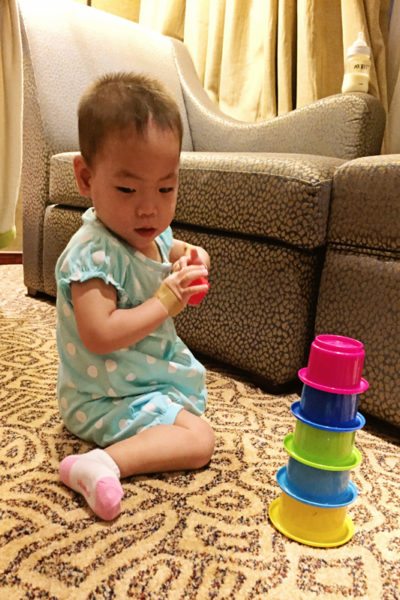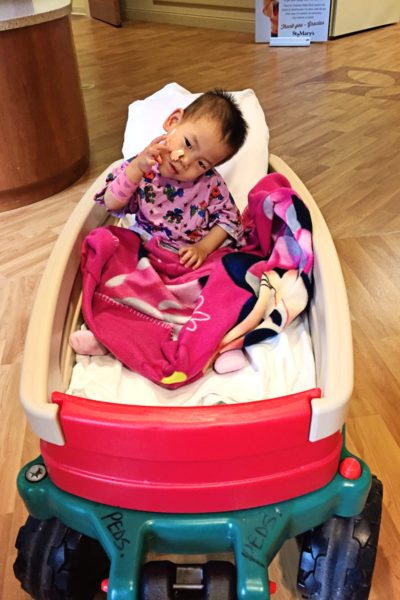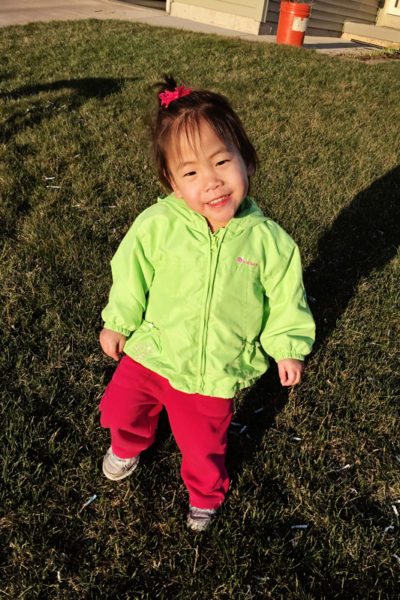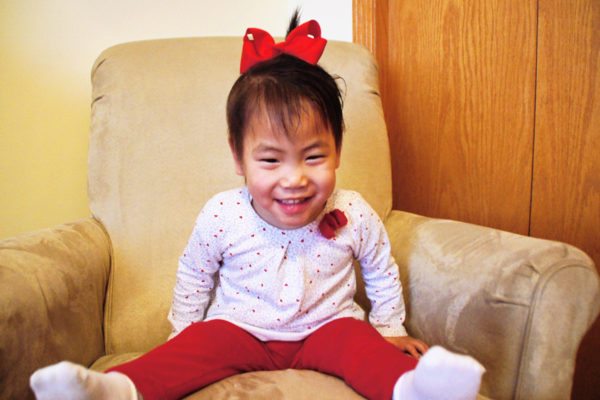We began our adoption journey about three years ago and in that time we completed two separate adoptions. We first traveled to China in 2015 to bring home our son who was just a year old at the time and in 2016 we re-used our dossier bringing home our daughter who had just turned two.
When we adopted our son, I recall it being a very smooth process. He was happy, smiley and opened up to us right away. We had a few challenges with food insecurities at first but not many. He would cry as we attempted to remove an empty bottle from his little hands or when his food bowl was empty but when made meals and snacks consistent. He realized that food was readily available and we quickly saw the insecurities disappear.
When we adopted our daughter we could tell right away that it was going to be a lot harder getting her to open up and trust us. The day we received her she was sad, scared and very leery to try anything. She also had severe food insecurities, much more than our son did. Where our son was a good eater, she had a complete aversion to food.
Our first sign that she had an aversion to food came the same day we received her. When we got back to our hotel we spent some time getting to know each other and made the first attempt to feed her which did not go very well. She would take a bottle of formula fine but any time we got near her with a spoon full of food she would have a complete melt down.
At first we figured this aversion was just her needing time to adjust but any time we attempted to feed her anything other than a formula bottle we received the same result. We tried some of the baby snacks we brought like rice wafers and yogurt bites thinking maybe feeding herself would do the trick but sadly no. I even tried cutting the tip off of a bottle and adding rice cereal to her formula – but we quickly found out that was a big mistake. She refused it and when I tried to go back to a regular formula bottle she rejected that for quite a while.
Eventually we were able to coax her back to the formula bottle – but we realized what a slippery slope we were on with her aversion to eating.

After we arrived home from China our first couple of weeks went pretty well. We caught up on sleep, our daughter continued to get more comfortable with her new surroundings, she and our son got to know each other. We also visited our pediatrician who had concerns about her weight (only 19 pounds) and the aversions to food she was having. She started us on the path of many different doctors’ appointments which included a pediatric gastroenterologist – to see if there was something internally causing her food aversions – and feeding therapy.
While we waited for each of the appointments, we continued to try everything we could to get her to eat but she still refused anything we tried to give her. Day after day we tried hoping one day we’d get a small break. Finally we did! One day we placed soft table foods on her tray, ones that we knew she could feed herself and she completely surprised us and tried it! Even though this was our first tiny victory we knew we still had a lot of work to do – even though she was putting food in her mouth she wasn’t chewing or swallowing it, and much of it came back out.
As the first few weeks at home passed by, we continued to celebrate the small victories our daughter had battling her food aversions. She was doing so well until the day she became sick with a respiratory virus and her response to it was to shut down and go on a complete food and liquids strike. This was pretty scary for us as we tried everything we could to get her to eat and drink. After battling this strike for four days, which included two long nights in the ER, her weight dropped to 18 pounds and we had no choice and but to admit her to the hospital.
When they admitted her they listed her as failure to thrive and emotionally that was hard to hear. You try to not take it personally because as soon as this little person is placed your arms you do everything you can to help them to grow and thrive. After being admitted to the hospital we had to face a harsh reality: what this sweet little girl was battling inside was much deeper than what we could do on our own to help her.

The first few days of our hospital stay were hard with multiple blood draws, IV fluids, tests and multiple strange people coming in and out of the room. It became even harder when our daughter needed a feeding tube so she could start getting the nutrition her little body so desperately needed.
While the feeding tube was scary and daunting at first – especially when trying to figure out how to incorporate this into our daily lives – it eventually became the best thing we could have done for our daughter. It definitely had its negatives and challenges, and took extra planning if we were out and about for a day or traveling, but the nutrition it was giving her to grow and thrive was worth the frustrations. It gave her the nutrition she needed while giving her the time and the ability she needed to figure out how to eat and drink on her own again.
After leaving the hospital we settled into our new norm with her feeding tube and attended the appointments we had scheduled with the pediatric gastroenterologist and feeding therapists hoping to find the answers we needed regarding her food aversions. Our appointment with the gastroenterologist had us scheduling an endoscopy procedure for our daughter to see if there was anything internally that could be causing her feeding issues.
As hard as it was to put her through all that again it did finally solved a piece of the puzzle. The biopsies they took of her stomach and intestines came back saying she had a very severe case of H-Pylori, a bacteria which can cause an infection in the lining in your stomach.
During next few weeks she received two rounds of treatment that contained four different antibiotics to kill the infection along with multiple medications to help heal her stomach and reduce any reflux issues she was having. While she was being treated, the medications were definitely helping her and you could tell she was feeling better. She was feeling so much better that she slowly started showing interest in food again, but not any liquids.

Shortly after her H-Pylori diagnosis we were also able to attend our first of many feeding therapy appointments. In the beginning her progress was slow. The biggest hurdle that we initially tackled with her was trust. The foods we would see her try and eat were usually crackers and rice wafers: foods that were bland and dissolvable, safe foods that wouldn’t hurt her tummy.
Our first goal was to try and get her to trust different foods and get her willing to try them on her own.
About four months into feeding therapy and watching her slowly progress we finally had a huge breakthrough. From the time she stopped drinking and received the feeding tube we never stopped trying to give her bottles or sippy cups hoping that one day the urge to drink orally would kick back in again. One day we had a sippy cup of water out for her and she decided on her own to start drinking from it!
Eventually this became continual for her and we started replacing the water with the formula she was getting through her feeding tube. It didn’t take long and she was drinking her daily amount of formula through the sippy cup and we no longer needed to use her feeding tube. Because she was doing so well and maintaining her weight drinking the formula orally, we were able to finally remove the feeding tube.

As we continued to progress through feeding therapy, we finally had our next big breakthrough moment with her. She finally took a spoonful of food! Not only was this a tremendous moment for us but we were finally able to figure out another piece of her puzzle: she didn’t know how to eat. This was a developmental milestone that she had missed.
When the therapists were able to see her finally eat from a spoon, they determined that we were at square one in teaching her how to eat. Knowing this we backtracked on what we fed her removing any table foods and starting with simple baby foods and cereal. It was slow going at first as the spoon was touch and go at times but she eventually started loving the baby food and the spoon became her best friend.
As the therapists predicted, she moved through the stages of eating very quickly. Once she eventually learned to chew and swallow she became an eating machine and some days she even eats more than our son. Sometimes when we watch her eat we shake our heads wondering where this little girl was just nine months ago.

There are still the days where she doesn’t eat well and the days when she gets sick that the fears creeps back and we get nervous not knowing if she getting enough liquids through the day and worrying if she’s going to revert and avoid eating and drinking all over again. Although she has improved so much with her eating and drinking we are still fighting an uphill battle and will be for some time.
I know our daughter overcame many of her food insecurities in a relatively short amount time and I know that isn’t the case for everyone. Some will battle with food insecurities for years and some for a lifetime. For us the pieces to the mystery were scattered all over. Sometimes the pieces fit together quickly and easily and other times it took longer for them to fit into place.
I hope our story can help others know that even though this battle is hard – even exhausting at times – it can be won. The victories may sometimes seem small in the moment but are ultimately so significant and so rewarding.
– guest post by Laura

























Leave a Reply